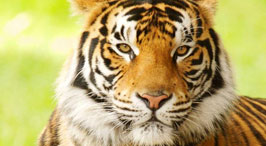WILD LIFE
RESORTS
Bandhavgarh Resort Bharatpur Resort Gir Jungle Resort Jim Corbett Jungle Resort Kanha Resort Kaziranga Jungle Resort Panna Jungle Resort Periyar Jungle Resorts Ranthambhore Resort Sariska ResortNamdapha National Park
Namdapha National Park

Namdapha National Park is the largest protected area in the Eastern Himalaya biodiversity hotspot and is located in Arunachal Pradesh in Northeast India. It is also the third largest national park in India in terms of area. It is located in the Eastern Himalayan sub-region and is recognized as one of the richest areas in biodiversity in India. The park harbours the northernmost lowland evergreen rainforests in the world at 27°N latitude. The area is also known for extensive Dipterocarp forests.
The park is located in Changlang district of the Northeastern state of Arunachal Pradesh, near its border with Myanmar. It spans an area of 1985 km2 with 177 km2 in buffer zone and 1808 km2 in the core area. The park is located between the Dapha bum range of the Mishmi Hills and the Patkai range with a wide altitudinal range between 200 m asl and 4571 m asl. The area falls under both the Palearctic and Indo Malayan biogeographic areas resulting in a diverse species assemblage. The habitat changes with increasing altitude from tropical moist forests to Montane forests, temperate forests and at the higher elevations, to Alpine meadows and perennial snow. The park has extensive bamboo forests and secondary forests in addition to the primary forests.
Because of many different vegetation zones, the park is home to a great diversity of mammal species. Four big cat species occurre in the park: snow leopards, clouded leopards, common leopards and tigers. Other large predators are dholes, wolves, and Asiatic black bears. Smaller carnivores include red panda, red fox, yellow-throated marten, Eurasian otter, Oriental small-clawed otter, spotted linsang, binturong, common palm civet, small indian civet, large indian civet, masked palm civet, marbled cat, fishing cat, Asiatic golden cat, and two species of mongoose. Large herbivores are represented by elephants wild boar, forest musk deer, indian muntjac, hog deer, sambar, gaur, common goral, mainland serow, takin and bharal. Seven species of non-human primates including Stump-tailed macaque and Slow Loris, Hoolock Gibbons, Capped Langurs, Assamese Macaques and Rhesus Macaques.
The earliest papers on the birds of Namdapha were published in 1990. The park has about 425 bird species with many more to be recorded from work in the higher areas. There are five species of Hornbills recorded from the area. Several species of rare wren-babblers have been recorded in Namdapha. Other bird groups include laughing thrushes, parrotbills, fulvettas, shrike babblers and scimitar babblers. The Snowythroated Babbler is a rare species of Babbler found only in the Patkai and Mishmi hills and nearby areas in Northern Myanmar, is found in Namdapha. Other rare, restricted range or globally endangered species include the Rufous-necked Hornbill, Green Cochoa, Purple Cochoa, Beautiful Nuthatch, Ward’s Trogon, Ruddy Kingfisher, Blue-eared Kingfisher, White-tailed fish eagle, Eurasian Hobby, Pied Falconet, White-winged Wood Duck, Himalayan Wood-owl, Rufous-throated Hill-partridge, and Whitecheeked hill partridge. Several leaf warblers and migrants such as Amur Falcon and several Thrushes can be seen here. The first mid-winter waterfowl census in Namdapha was conducted in 1994 when species such as the White-bellied Heron, a Critically Endangared bird was recorded for the first time.



